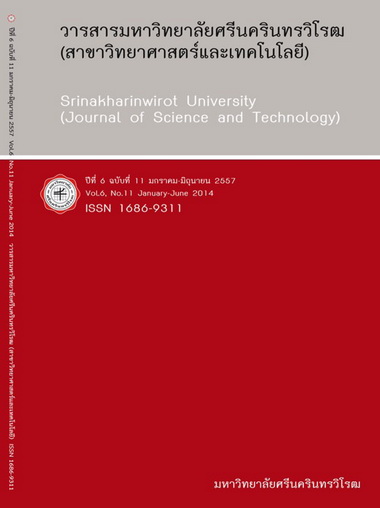การจำแนกสายพันธุ์ของเชื้อ Vibrio parahaemolyticus โดยวิธีการศึกษา ทางฟีโนไทป์และจีโนไทป์ PHENOTYPING AND GENOTYPING OF Vibrio parahaemolyticus
Keywords:
Vibrio parahaemolyticus, seafood poisoning, epidemiology, antibiotyping, AP-PCR, ERIC-PCRAbstract
บทคัดย่อ
Vibrio parahaemolyticus เป็นสาเหตุสำคัญของโรคอาหารทะเลเป็นพิษ การจำแนกสายพันธุ์ของเชื้อจึงเป็นสิ่งจำเป็นเพื่อประโยชน์ทางด้านการศึกษาระบาดวิทยา รวมถึงการควบคุมและป้องกันการแพร่กระจายของเชื้อ การวิจัยครั้งนี้ศึกษาการจำแนกสายพันธุ์ของเชื้อโดยวิธีการศึกษาแบบแผนการดื้อยา (antibiotyping), arbitrarily-primed polymerase chain reaction (AP-PCR) และ enterobacterial repetitive intergenic consensus sequence-polymerase chain reaction (ERIC-PCR) พบว่าเชื้อที่แยกได้จากผู้ป่วยจำนวนทั้งสิ้น 70 ไอโซเลท จำแนกโดยวิธี antibiotyping, AP-PCR และ ERIC-PCR ได้เป็น 1, 16 และ 24 สายพันธุ์ ตามลำดับ จากการประเมินความสามารถในการจำแนกสายพันธุ์ของเชื้อพบว่าantibiotyping มีความสามารถในการจำแนกต่ำที่สุด (discriminatory index เท่ากับ 0) ซึ่งไม่สามารถจำแนกความแตกต่างระหว่างสายพันธุ์ของเชื้อได้ ขณะที่ ERIC-PCR เป็นวิธีที่มีประสิทธิภาพสูง เมื่อเปรียบเทียบกับ AP-PCR โดยมีค่า discriminatory index เท่ากับ 0.932 และ 0.901 ตามลำดับ อย่างไรก็ตามวิธี AP-PCR มีข้อดีคือ PCR product ที่ได้มีจำนวนแถบน้อยกว่า ในทางปฏิบัติทำให้ง่ายต่อ
การแปลผล และหากจำแนกสายพันธุ์ของเชื้อโดยการแปลผลร่วมกันระหว่าง AP-PCR และ ERIC-PCRพบว่าประสิทธิภาพการจำแนกสายพันธุ์ของเชื้อสูงขึ้น (discriminatory index เท่ากับ 0.986) โดยสามารถจำแนกเชื้อได้ทั้งสิ้น 48 สายพันธุ์ การศึกษาครั้งนี้แสดงให้เห็นว่าการจำแนกสายพันธุ์โดยใช้เทคนิค PCR พื้นฐาน เช่น AP-PCR, ERIC-PCR และการใช้ AP-PCR ร่วมกับ ERIC-PCR เป็นวิธีที่มีศักยภาพสูง เหมาะสำหรับนำมาใช้ประโยชน์ในงานทางด้านระบาดวิทยาได้ดี
Abstract
Vibrio parahaemolyticus is most commonly associated with seafood-borne gastroenteritis. Several typing methods have been developed for epidemiologic investigations or controlling the spread of this pathogen. In this study, a total of 70 clinical isolates of V. parahaemolyticus were typed by antibiotyping and the PCR-based typing methods: an arbitrarily-primed polymerase chain reaction (AP-PCR) and the enterobacterial repetitive intergenic consensus sequence-polymerase chain reaction (ERIC-PCR). The seventy isolates were classified into 1, 16 and 24 types, with discriminatory indexes of 0.000, 0.901 and 0.932, by antibiotyping,
AP-PCR and ERIC-PCR, respectively. The discriminatory power of antibiotyping was lowest and all clinical isolates tested were indistinguishable by this method. ERIC-PCR was preferable
to AP-PCR because of the higher discriminatory power. However, AP-PCR might be a practical method because it generated fewer amplification bands and patterns than ERIC-PCR. The combination of AP-PCR and ERIC-PCR analysis allowed us to classify the isolates into
48 types with the highest discriminatory index of 0.986. These data demonstrate that AP-PCR and ERIC-PCR are useful for strain typing of V. parahaemolyticus and the combination of these two techniques is recommended for epidemiologic investigations.
Downloads
Downloads
Published
How to Cite
Issue
Section
License
Srinakharinwirot University Journal of Sciences and Technology is licensed Under a Creative Commons Attribution-NonCommercial-NoDerivs 4.0 International (CC-BY-NC-ND 4.0) License, Unless Otherwise Stated. Please Read Journal Policies Page for More Information on Open Access, Copyright and Permissions.


